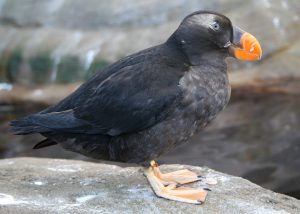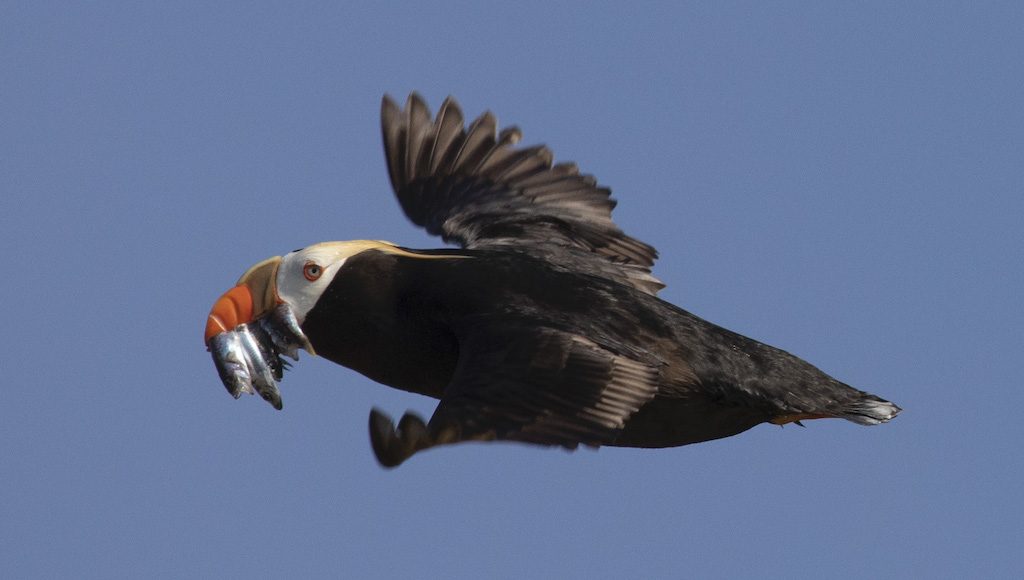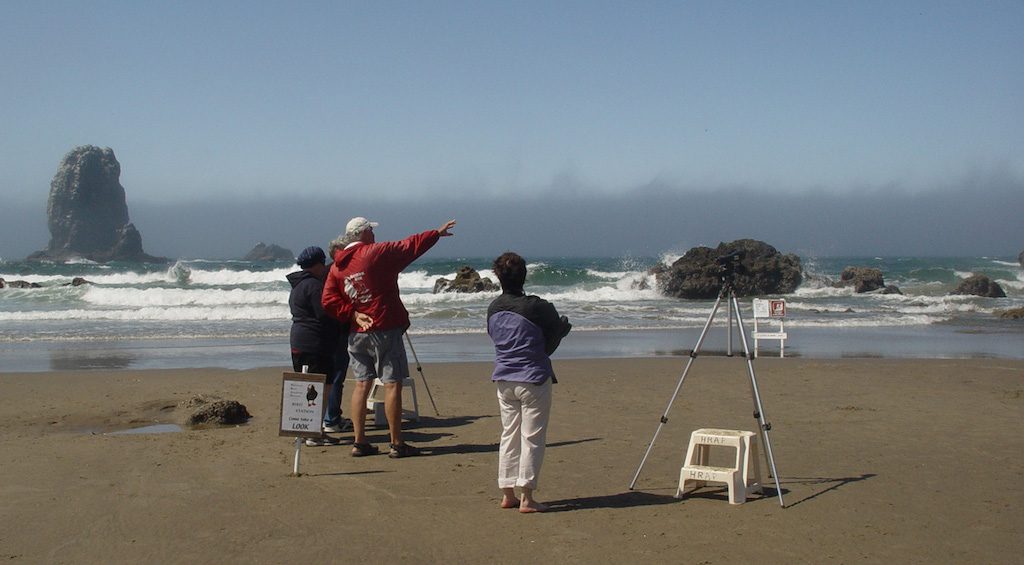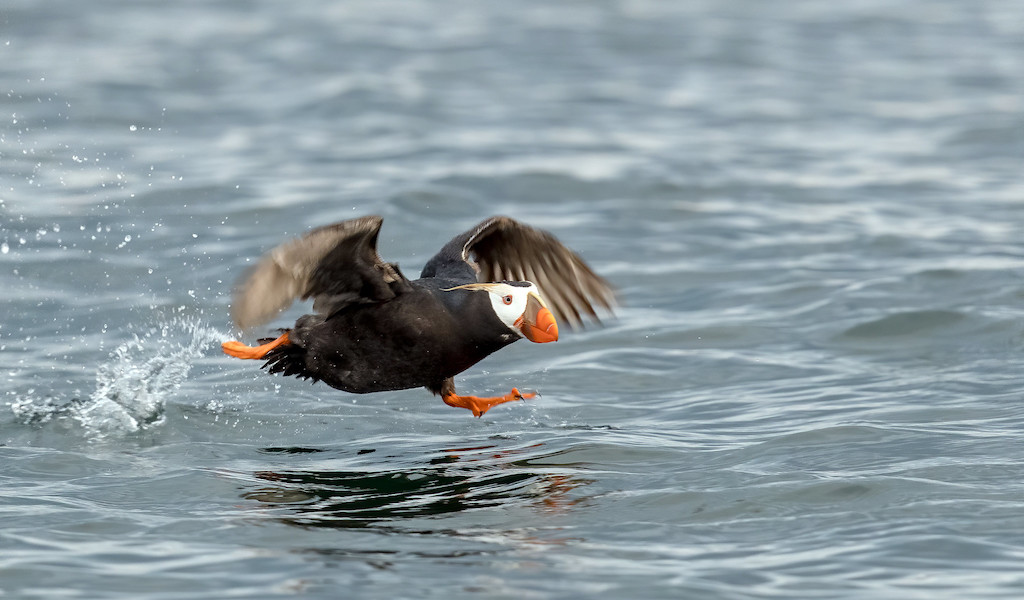Occasionally, this space includes reports and essays from guest writers on the subject of Puget Sound ecosystem recovery. Biologist and author Eric Wagner has this look at the federal government’s recent decision to decline special protection for the tufted puffin under the Endangered Species Act. While the U.S. Fish and Wildlife Service says that the puffin has “robust populations across the majority of its range,” the bird’s numbers in Washington, including Puget Sound, have dropped severely in recent years. Wagner recalls what it was like when things were different and the colorful bird known as the “sea clown” could be spotted more easily.
By Eric Wagner
In the December 3, 2020 issue of the Federal Register, tucked between a correction from the Pipeline and Hazardous Materials Safety Administration and a NOAA decision on Pacific cod fishing permits, the U.S. Fish and Wildlife Service published a notice saying the agency was declining to list eleven species as endangered or threatened under the Endangered Species Act. Many of the species I had never heard of: three types of pyrgs (snails), the relict dace (a fish), the Clear Lake hitch (another fish). But one I knew well: the tufted puffin.
I grew up near the northern Oregon coast watching tufted puffins nearby at Cannon Beach, where a few dozen pairs nested on Haystack Rock. They were closest thing the town had to a local celebrity. Come April, all sorts of people—not just birders—would go down to the rock to start the annual puffin vigil. Before long the birds would oblige. First one, then two, then more and more would appear, their stubby shapes flying circuits around the 235-foot-tall coastal monolith among the clouds of gulls. Eventually they would land on the rock’s grass-covered summit and disappear into their burrows to breed.

Tufted puffins are striking birds in the auk family. With their two congeners, the horned and Atlantic puffin, they are sometimes called sea parrots, or the clowns of the sea. Adults can grow up to sixteen inches long and weigh more than two pounds. They wear a sleek cloak of black feathers throughout the year, but when breeding their face turns so white it looks painted. Their large bills, too, become a brilliant orange, and they grow long thick creamy tufts above their eyes. Standing outside their burrows and gazing into the middle distance, the wind ruffling both the grass around them and the tufts on their heads, they could cut comically serious figures. Or maybe it was seriously comic. Whatever the case, everyone loved the puffins.
The sea clowns, alas, have become increasingly rare of late, not just in Oregon, but all up and down the West Coast. In Washington, tufted puffins were once common in the Strait of Juan de Fuca and along the outer coast, with 25,000 birds spread among 44 known breeding colonies in the early 1900s. Those numbers stayed stable for the next several decades; surveys in the 1970s and 1980s estimated more than 23,000 birds bred at 35 known colonies. Then the bottom started to fall out. By 2009 biologists estimated that fewer than 3,000 puffins bred in Washington, and the number of known colonies had fallen to just 19. Counts since then have only gotten worse. In the Salish Sea, colonies at Protection Island and Smith Island have shrunk almost to nothing.
A suite of factors has driven the puffin’s decline. In June 1991, for instance, the Tenyo Maru, a Japanese fishing vessel, sank about 25 miles northwest of Cape Flattery, spilling over 400,000 gallons of fuel oil. Thousands of seabirds were killed, including an estimated 9% of the state’s puffins. But even as the risk of oil spills from rising vessel traffic remains a concern, changing oceanic conditions and large-scale declines in marine productivity are the greater existential threat. These changes have made it harder for puffins to find their preferred forage fish prey, harder for them to raise their chicks (called, naturally, pufflings). It was for this reason that in 2014 the Natural Resources Defense Council petitioned the U.S. Fish and Wildlife Service to list the puffins of the contiguous states as a distinct population segment—the same approach used to protect the southern resident killer whales and some individual salmon runs.

Getting a species listed can clearly take a long time and is frequently subject to litigation, so federal officials usually go to some length to explain how they arrived at their conclusions. Where other species in the December 3 notice had several paragraphs devoted to the rationale behind the decision, the tufted puffin received only three: the species is widely distributed across the North Pacific Ocean, with 82% of the population being in North America, and most of that in Alaska (first paragraph); although the species faces a range of threats, from climate change to oil spills to fisheries bycatch to human disturbance, “the best available information for tufted puffins indicates adequate redundancy and representation across the species’ range, including robust populations across the majority of its range” (second); on account of this robustness, listing was not warranted (last).
Conservation biology is considered an applied science, which implies a sort of practicality. But conservation as an act is at heart aspirational, even idealistic. Some organism is at risk of going extinct if things continue unchanged. Only by stopping or curtailing certain human behaviors, be it logging or fishing or hunting or draining an aquifer or building a subdivision or filling a waterbody with toxins or pumping greenhouse gases into the atmosphere for two hundred years—the list is very, very long—do the odds of that organism’s survival increase even a little.
Ecological dynamics, on the other hand, can hardly be called idealistic. They tend instead to be binary: dead or alive, growing or shrinking, here or not here. But ecology can have its aspirational moments if you will. Not to imply intent, but a species is an ambitious entity. It seeks to occupy as much space as it can, given its physiological needs and the resources available. You see this with the tufted puffin. It needs a place to nest and fish to eat. California, Oregon, and Washington represent the southern tip of the species’ range. In this they are, in a way, aspirational. Yes, most of North America’s tufted puffins are in Alaska, but for some period of time a good number were able to venture south and make a home on the rugged sea stacks, sandstone cliffs, and windswept islands along the coastline abutting the California Current.

No longer. Here, the practical leanings of conservation, at least as the U.S. Fish and Wildlife Service conceives it, become clearer. It is true that across much of its range the tufted puffin is abundant. Some colonies in the Aleutian Islands may host more than 100,000 birds. In ecological terms the species appears to be going through a range contraction, abandoning marginal habitat while staying robust in its core habitat. While range contractions can herald larger problems to come, they are not uncommon. That Washington, Oregon, and California will lose the tufted puffin is unfortunate but not unendurable so long as plenty remain in Alaska. That said, with the puffin, it is unclear how much longer their core habitat will be so suitable; the number of seabird mass mortality events in the North Pacific is on a worrisome rise. Soon we may have to have a conversation about puffin conservation in which the declines are widespread and undeniable no matter the prism through which one chooses to view them.
But that will be a matter for another day. For those of us on the West Coast, there is not much to do other than head out in spring, wait for the puffins to return, see how many are left, and learn a little about their lives so that, should the need arise, more assertive steps can be taken. How much longer they will cling to these territories with their little toe claws is uncertain. If they continue to decline at the current rate, they have perhaps forty years left in Washington. I for one will be sorry to see them go. But it was nice to have them while they were here.
Eric Wagner writes about science and the environment from his home in Seattle, where he lives with his wife and daughter. His writing has appeared in Smithsonian, Orion, The Atlantic and High Country News, among other places. He is the author of “Penguins in the Desert” and co-author of “Once and Future River: Reclaiming the Duwamish.” His most recent book is “After the Blast: The Ecological recovery of Mount St. Helens,” published in 2020 by University of Washington Press. He holds a PhD in Biology from the University of Washington.
